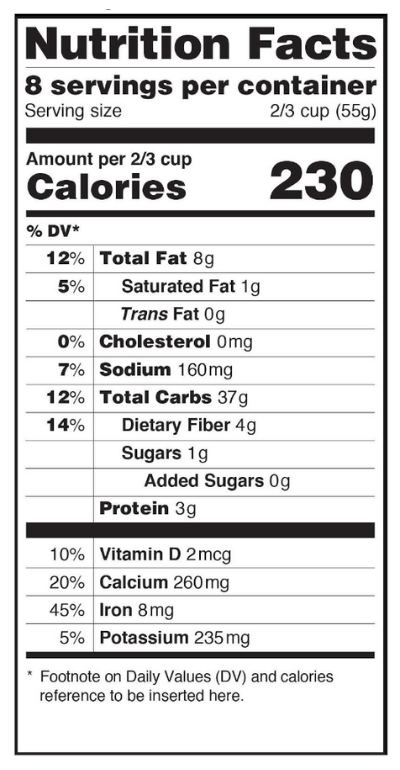If you’ve been following me for a while, you know that I endorse whole, real food as the best way to restore metabolic health. However, I know going ‘cold turkey’ isn’t viable for everyone — and it can be tough to choose metabolically-healthy foods when food and beverage companies sneak ‘extras’ into the mix.
Knowing how to read an ingredients label is paramount for metabolic health. It’s also a great way to reassess your eating habits and cut out foods that don’t serve your goals.
Here’s what you need to know.
A brief history of the ingredients label
The concept of food labels began in the 1850s as a response to food-borne illness. After the death of President Zachary Taylor to contaminated food, President Abraham Lincoln created the USDA to enforce strict guidelines around food packaging, handling, and processing.
The 1960s brought additional changes with the advent of ultra processed foods (or UPFs). In response to the consumer’s high demand for packaged cookies, cakes, and microwave meals, the USDA mandated established food labels for products sold in multiple states.
The USDA mandated their standardized Nutrition Facts label for all foods in 1990. Today, every product displays standard information about serving sizes, ingredients, and Percent Daily Values — including pre-washed fruits and vegetables.
And here’s where the problems begin.
Breaking down Nutrition Facts

The ‘Nutrition Facts’ label has become an iconic part of the grocery shopping experience. Raw, whole produce rarely requires a label, but items stacked in the center aisles likely have a list.
There are three major sections of the Nutrition Facts label: calories, percent daily values, and the actual ingredients list.
Let’s take a closer look at each of these.
Calories
Many of us rely on caloric content to make decisions for food. This is especially true if we’re on a diet — something I struggled with for many years.
However, calories are a very poor measure of food and its ‘healthiness.’ It’s not even a scientifically sound metric, since the intricacies of digestion and gut flora can change the values for each person.
Calories also don’t account for the quality of a food or how it’s cooked, which dramatically changes its digestible content. And since the FDA allows inaccuracies in calorie counts by up to 20%, that cereal bar you eat for lunch may be 300 calories instead of 250.
Wouldn’t it be better and easier to eat whole, real foods instead?
Percent Daily Values
PDVs give you a specific percentage of how much a food’s ingredients complete your daily values. This means 160 milligrams of sodium, according to their guidelines, would be 7% of your recommended ‘daily value’ of sodium.
What do they base these daily values on? The FDA’s predetermined numbers — based on a 2,000 calorie diet, of course.
As we know, calories aren’t a foolproof method of measuring food for energy. And interestingly enough, many of the FDA’s numbers don’t reflect a metabolically-healthy diet:
- Added sugar: The FDA recommends 50 grams per day. However, eating more than 24 grams of added sugar per day can lead to obesity, diabetes, and heart disease.
- Total carbohydrate: The FDA recommends 275 grams per day. However, low-carb diets such as keto and carnivore consistently see better health outcomes and reduce the markers of inflammation.
- Protein: The FDA recommends 50 grams per day. But again, this is based on 2,000 calories per day — not on your body weight or activity level (like it should be).
- Fat: The FDA recommends 78 grams per day. Not only does this fail to distinguish between healthy fats and seed oils, but it’s less than half of the recommendation for keto and carnivore diets.
- Sodium: The FDA recommends 2,300 milligrams per day. However, reducing your intake either at or below this number may not have a substantial impact on heart health.
I’m not saying the Nutrition Facts label misrepresents the values of these foods (like the grams of fiber per serving). However, I am saying that Percent Daily Values may be a poor guide for metabolically healthy eating — especially when some of the numbers run counter to scientific evidence.
The ingredients list
Processed foods list all their ingredients from the heaviest weight to the lightest weight. This means the first few ingredients on the list have a higher concentration than the last few ingredients.
There are a number of ingredients to avoid in modern food, especially with the advent of UPFs. These include:
- Added sugar. There’s no reason to add sugar to products like ketchup, soup, or salad dressing. This also includes fake sugars, which can sneak into your food and disrupt your metabolic health.
- Reduced fat products. Not only do low-fat diets lead to health problems over time, but they also require lots of added sugar to feel satiating and palatable.
- Colorants and dyes. Like added sugar, there’s no added benefit of using dyes in foods — although they can lead to significant health problems.
- Seed oils. Soybean, sunflower, canola, and vegetable oils can wreak havoc on your metabolic health.
- The unpronounceable ‘extras.’ You must approach preservatives (like nitrates and nitrites) with the utmost caution. This is especially true of beef jerky and other packaged meats.
Keep in mind the FDA doesn’t require food companies to list their exact recipes or cooking processes. That’s one of the reasons why most ‘olive oil’ is actually a blend of lower-quality seed oils.
So how do you read a food label?
These days, you can’t be too careful about what’s in your food.
Whenever you grab a packaged meal or frozen dinner off the shelf, ask yourself:
- Do the ingredients in this food support my metabolic health?
- Are there any ingredients I don’t understand or feel comfortable with?
- Can I verify the purity of the product and claims on the packaging?
In my opinion, the best way to avoid the pitfalls of food labels is to stop buying ultra processed foods. Instead, you can buy whole, real foods and cook at home to eat metabolically healthy without the guesswork.
If you want more personalized guidance for food, nutrition, and metabolic wellness, you can partner with a personal coach in my Elite Coaching Program. This unlocks access to private coaching calls, group support, monthly AMAs, and all my metabolic coursework.
